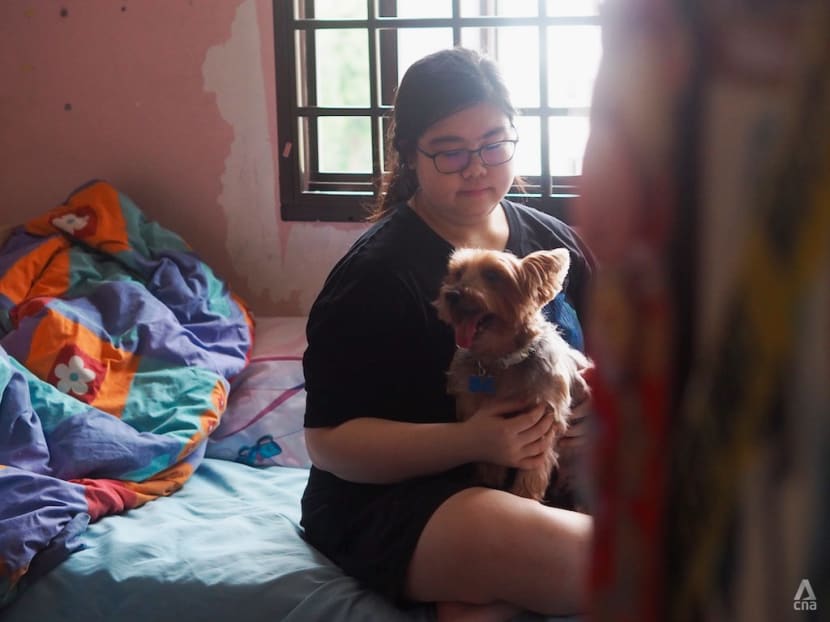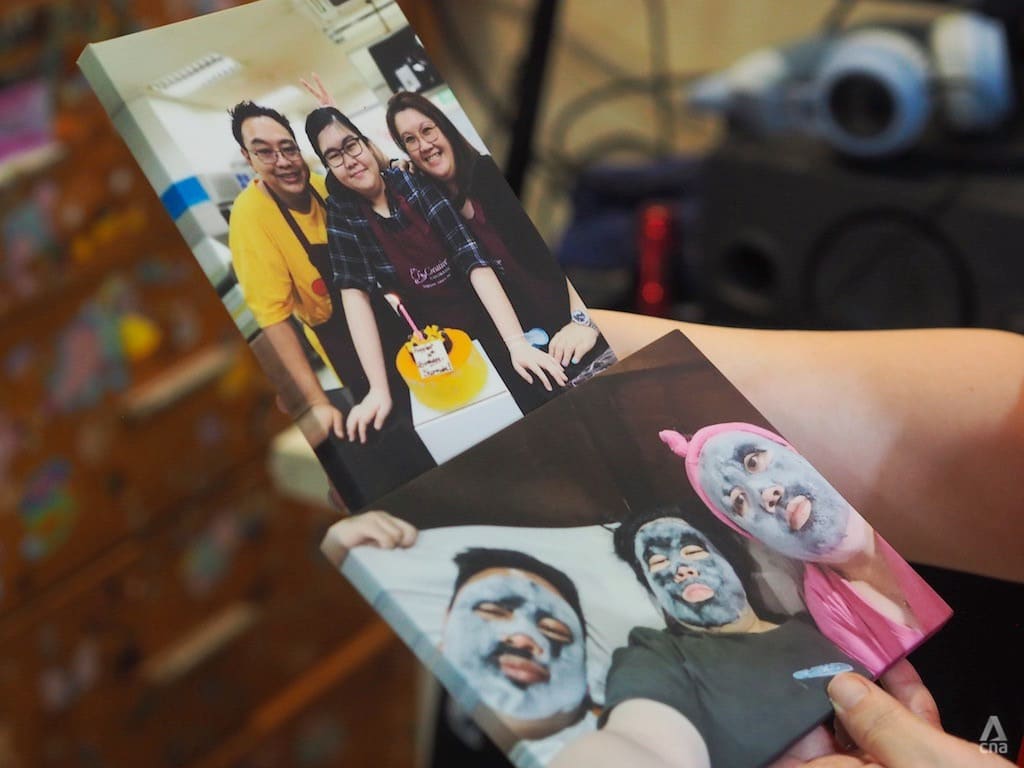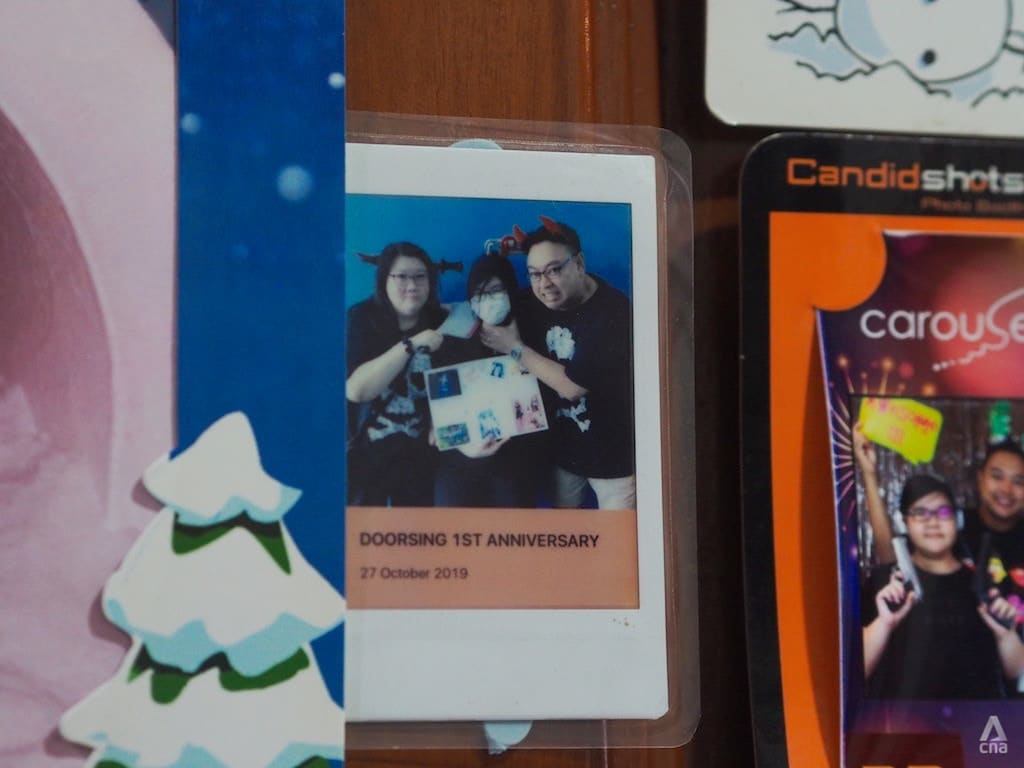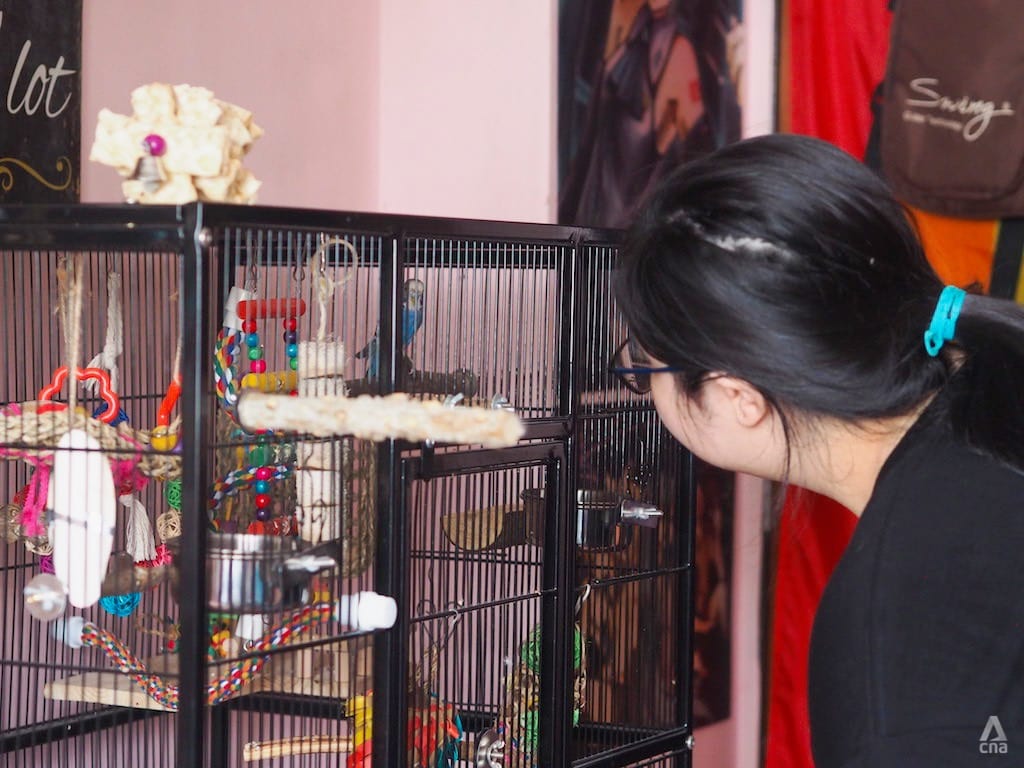Life with selective mutism: When extreme anxiety makes a child unable to speak
Children with selective mutism can’t speak in certain environments, so they might be labelled as rude. But the lesser-known condition is not so straightforward. CNA speaks to a family whose daughter can “freeze” for up to five hours when her condition gets triggered.

Shermaine is very comfortable around animals, and can passionately talk about her pets. (Photo: Grace Yeoh)
SINGAPORE: To step inside Shermaine Toh Zeppelin’s mind, picture yourself alone in a box made of one-way mirrors.
You can see people trying to reach you from the other side, but they can’t see you trying to reciprocate. You wave, bang the walls, jump up and down. Nothing works.
They don’t know why you can’t respond to them — and you can’t explain it either.
“I just feel as if I'm unable to speak. Last time, I asked my friend to ask me a yes or no question, so I could just reply with a yes or no. But I couldn’t make sounds come out of my throat,” the 16-year-old told CNA.
“When I freeze, I am fully able to see, hear and feel everything that I usually can. I just can't move. I remember one of my teachers telling me to make eye contact with her if I was ‘in there’, and I couldn't make eye contact.”
Shermaine was diagnosed with selective mutism in 2016 — a “rare condition” with public hospitals seeing an average of 140 patients a year from 2018 to 2020, the Institute of Mental Health (IMH) told CNA.
Selective mutism is a childhood anxiety disorder characterised by a child's inability to speak and communicate effectively in select social settings where there might be an expectation to do so, such as in school or in public.
However, they are able to communicate in settings where they are comfortable, secure and relaxed.
“Children with selective mutism can even shout and be boisterous when they interact with familiar people, like household members, but they may become shy and anxious with others, such as distant relatives, teachers, classmates, hawkers or strangers,” explained IMH.
This was initially apparent when CNA spoke to Shermaine over Zoom with her parents, where Shermaine kept silent when her parents were talking.
When it was her turn, she’d written down her answers to the interview questions that were sent over beforehand, intending to read them out. But her mother ended up reading them out for her, until Shermaine took over around the third question.
Her answers began with a whisper, but her voice grew louder with every sentence.
The girl who spoke was unlike the one who has frozen up to five hours after being triggered.
TRIGGERING INCIDENTS IN SCHOOL
It started in Primary 3, when Shermaine’s teacher started “nitpicking” various aspects about her, shared her father Mr Zeppelin Misnadi.
“I don’t want to call it targeting (her). It’s more like nitpicking, small things, big things, everything, like saying she’s sweaty, perspiring a lot, she looks untidy. (Small) comments from her, but they’re actually a very big issue to Shermaine.”
Shermaine explained that at certain times, such as after recess on a hot day, the teacher would say she was “very sweaty” and ask her to wipe her perspiration.
“I have a handkerchief in my pocket. I’d take it out, then she said I shouldn't use a handkerchief, I should use a tissue. I was like, ‘What?’ She’s also the one who tells us not to waste paper,” she said.
When Mr Zeppelin and his wife, Madam Sharon Toh, initially heard about Shermaine’s discomfort from her, they didn’t make a big fuss.
“We didn’t know it was going to be a big deal. We were comparing our life with hers, which we think is wrong in hindsight,” they shared.
“Probably we could’ve done something or understood her better. But we based (our reaction) on what we went through in life. We thought it’s a passing phase, and she would outgrow it like us. We didn’t know she had anxiety.”
He added that whenever Shermaine’s brain freezes, she would think it’s only been a few minutes once she snaps out of it. In reality, several hours could have passed.
To adapt to her primary school environment, she would order from the same canteen stall until the stall owner knew her order by heart. She also hung out with a small group of friends during recess.
Selective mutism in Parliament
In July, MP Hany Soh (PAP-Marsiling-Yew Tee) asked about support systems available in schools for children with selective mutism in a parliamentary question.
In response, the Ministry of Education (MOE) said teachers allow more "warm up" time to ease these students into lessons, such as having them arrive early, allowing for practice time before entering into a large group.
Teachers also provide them with "alternative modes of responding in the classroom to encourage participation", such as by using technology like WhatsApp and Padlet.
During examinations that require speaking or presentations, "special accommodations can be provided so that these students are not penalised for their inhibition in speaking", said MOE.
The school also works with school counsellors, allied educators and Response, Early Intervention, Assessment in Community mental Health (REACH) teams to support these students.
And when she entered secondary school, the school was affiliated with her primary school, so she was familiar with the environment. She also knew the majority of her classmates, including one she’d known since Primary 1.
With Shermaine’s consent, her parents also informed her new teachers about her selective mutism.
All seemed fine, until a relief teacher unknowingly triggered her condition again in Secondary 1.
“He called on me to stand up and read a few lines from the textbook, you know, normal school stuff. And I couldn't stand up or read it. I just sat there, not moving,” said Shermaine.
“After a few times of asking me to stand up, he asked me in Chinese. Then he told the person next to me to ask me to stand up, which she did, but I still couldn’t stand up. He asked if I was okay, and I still didn’t answer. Then he asked someone else to read.”
In another incident, Shermaine recalled using the game-based learning platform Kahoot in class in Secondary 2. For her username, she typed “I want to die” – it was “dark humour”, she said.
“My teacher deleted my name and told the person who put it to stand up. No one stood up. It was just silence waiting for the person to stand up. I was really scared; I was about to cry.”
She teared up as she texted her parents about the incident on the way home. And when she got home, she cried.
Shortly after the incident, Shermaine’s parents took her out of school, and she hasn’t been back since. They have accepted that she's simply taking a different path, and that she can complete her education in the future.
RAISING AWARENESS, FINDING SUPPORT
It was only after Shermaine’s school counsellor suggested that her parents contact mental healthcare service, REACH, that they first heard the term “selective mutism” when she was diagnosed.
Since then, her parents expressed that they believe the term is a misnomer.
“It says ‘selective’, but it’s not like whoever has selective mutism chooses not to talk to you. They don't have a choice,” said Mr Zeppelin.
“We want to spread this awareness that for some kids, it’s just a psychological issue, preventing them from speaking up like normal kids. They are normal, just that communication can be a big problem for them.”
More common misconceptions associated with selective mutism include believing that the child is shy, that they will outgrow the condition, that they have been traumatised, that they aren’t speaking because they’re oppositional, or that someone can force the child to speak, added Dr Daniel Fung, IMH chief executive and senior consultant in the Department of Developmental Psychiatry.

Shermaine’s parents also want to help her manage her selective mutism, because the anxiety linked to it spills over into her daily life.
“We want to encourage her to go back to school and resume normal life. But obviously most of it isn’t working, because it’s a huge hurdle. Once they go back to (an environment which causes anxiety), it makes it very hard to do normal things, like flagging a bus, ordering food or answering the door,” he said.
“It’s just like, say, a normal case of fever. You don’t go to school and have a fever, then come back home and you’re healthy. Outside of the school, there are also hurdles for her.”
Ultimately, Mr Zeppelin said, it’s about helping her beyond a school environment.
“(We want) to get her back to normal life. Isn't that the ultimate goal? School is just an interim step for her to get basic education. But if she can’t, there’s no SOP (standard operating procedure) or further talk about what we can besides that,” he said.
“I’m also in another caregivers group. Most of us are left alone. We have to find out what’s the next step,” added his wife, Mdm Toh.

Finding support can be hard, when there is “no manual”, especially since selective mutism is relatively unheard of, shared Madam Janet Wong, another parent whose son has selective mutism.
Mdm Wong is also a volunteer in the Facebook community group DoorSING, founded by her son Nigel Ng. SING is an acronym for Nigel’s book, Silence is Not Golden, written about his selective mutism.
“(This group name represents) opening a door and singing out loud, to break the silence,” she shared.
Mdm Wong added that parents also experience “low emotion”, when they’re bombarded by negative comments and thoughts.
As a result, the parents she works with have a private chat group, where they share their personal experiences and encourage each other.
“For my husband and I, we’re very happy-go-lucky, but of course we’re worried about Shermaine’s future, like what she’s going to do. I’m worried about how she’s going to feed herself when we’re gone. She can’t even order food, she can’t receive food at the gate,” said Mdm Toh, who is part of the DoorSING group.
The community aims to create a comfortable environment for children with selective mutism and their families to interact with each other. But Mdm Wong is cautious about making it seem like the children are “special” and hence need to participate in these activities.
“We just want them to know that these are the families that they can talk to. Parents also feel like people here will understand. When they share with other people whose kids don’t have selective mutism, those people would tend to say, ‘Aiya, your child is just shy lah,’” she said.
As a parent, she also acknowledged it’s important to model what acceptance of your child might look like for other people.
“Just tell people, yes, my child has selective mutism, and I just need your acceptance. I don’t need you to help if you can’t,” she said.
SEEKING PROFESSIONAL HELP
While support groups assist her parents with the caregiving aspect, Shermaine is also working with a trained therapist from REACH, who has helped her initiate conversations with strangers, such as by asking for the time or directions to a nearby location.
Signs of selective mutism
- Does the child present with the following behaviours?
- Speaks freely at home and to family members but becomes quiet in school and other situations
- Predominantly uses non-verbal gestures (like nodding, waving) to respond
- Only speaks to some teachers and classmates
- Will not speak to others, even in situations where they are being directly addressed
- Has difficulty initiating contact with people and asking questions for themselves (such as asking permission to go to the toilet)
- Poor eye contact with others
- Often seems anxious
- Looks frozen, or has rigid or awkward body posture
- Often appears shy and timid
- Has the child been having these behaviours for more than a month?
- Have these behaviours affected the child’s schoolwork and social relationships?
- Is the child familiar with the language spoken in social situations and comfortable with using the same language at home?
Source: Institute of Mental Health
Selective mutism can persist into adulthood if left untreated, said IMH's Dr Fung who co-authored a book on the condition, Finding Your Voice: Helping Children with Selective Mutism.
“They often grow up without learning appropriate social skills, and may become victims of bullying and grow to have low self-esteem as a result of an accumulation of anxiety and frustration,” he added.
“Their habits of not speaking may also become entrenched as time goes by. Many don’t outgrow selective mutism. The later they receive treatment, the lower the chances of success.”
Even though medication can be prescribed to help the child deal with their anxiety, Dr Fung said the first-line treatment for selective mutism is usually psychotherapy, which helps the child identify and modify their maladaptive thought patterns to change mute behaviour.
But outside the hospital, parents and teachers can also adopt practical strategies to get the child to speak.
“You can start by looking at the child, trying to get them to get your attention. You could also teach gestures, where they can point to what they want to eat or do. With every step that the child does, you can give them a reward for improvement,” advised Dr Fung.
Another strategy is a behavioural approach called conversational visits, he added.
“For example, if the mum and child speak normally to one another at home, we try to bring that speaking environment into the environments where the child is mute, allowing the child to still speak to the mum. Then we bring in others gradually into these mother-child speaking situations to encourage the child to speak to the third party,” he explained.
By doing so, the child slowly becomes accustomed with an unfamiliar environment, which can be “a scaffold” for them to speak.
LIFE BEYOND SELECTIVE MUTISM
When asked why she decided to publicly talk about her selective mutism now, knowing how much speaking to strangers can aggravate her anxiety, Shermaine gave an answer typical of a teenager.
“My parents told me to,” she said, without skipping a beat.

Mr Zeppelin and Mdm Toh explained that doing the interview and sharing about her condition was a way for their daughter to push herself to talk to people.
And talk she did. When CNA visited the Zeppelin household, Shermaine was vocal and friendly, boldly introducing her four pets (a dog, two rabbits and a bird) and rattling off trivia about their species and how to care for her animals.
She expressed her dream to be a zookeeper when she grows up, with a focus on reptiles, which she has been obsessed with since she read books about them at the library.
Like any teenager perennially on their phone, Shermaine also has a rich online life, where she participates in Discord servers. She even used to be “the most active member” in a channel, she said with a sense of pride.
She also creates YouTube videos, draws on her iPad, consumes an excessive amount of memes, and has plans to create a long Furby (a subculture that involves dismantling a standard Furby toy and attaching a mechanical spine to extend its body).
At home, Shermaine’s selective mutism fades into the background, but it only takes a question to bring it back to centre stage. Does she ever feel lonely?
“I realised I don’t want to be in school. I just want friends,” she replied, and this time she made sure she was heard.










